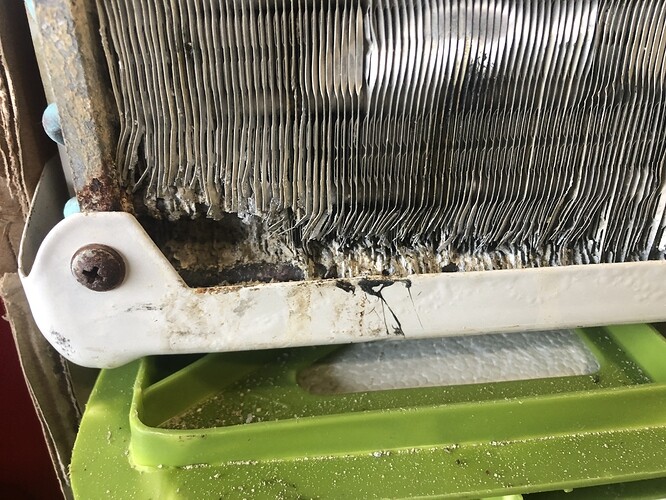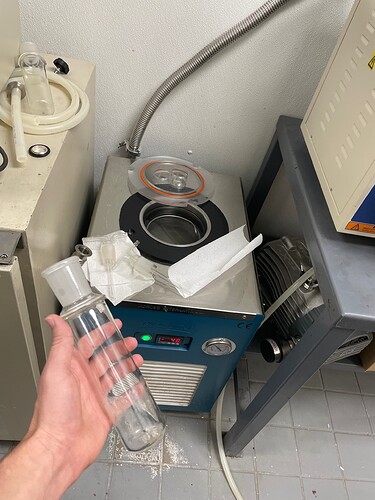I have a t40 AI cold trap that hasn’t been maintenanced in over a year. There’s no problems with it just wondering how to maintenance it and how often?
Damn.
Clearly not from the cannabis industry if you’re looking to fix it before it’s broken ![]()
![]()
![]()
Having a proactive maintenance schedule rather than a reactive one really helps keep things running smoothly. Good on you!!
If it’s been a year, chances are it could do with a blow job.
By which I mean; compressed air blown through the heat exchanger to remove the accumulated dust…how often you need to do this will depend on environment and duty cycle.
Other than that, most “maintenance” for chillers is about checking to see if they are broken yet (do they hold temp, are they leaking…)
What are common preventive maintenance schedules and checklists for chillers? Contains a couple of DOE lists on the subject.
Edit: I’ve had all sorts of equipment that works well only after I disassemble it and prove to it that it should work…one might hypothesize that proving to the equipment that it’s not broken, on a regular basis, would keep it in a functional state longer??
![]()
Shiiit I’ve been extracting for about 4 year but now I’m taking on responsibilities of manger kinda so maintaining and understanding equipment better and keeping things clean n what not.
So with the cold trap you don’t change out the chilling liquid? And is the heat exchanger the coil wrapped on the inside keeping the liquid -40?
I’m assuming you’re using a 50/50 mix of propylene glycol/distilled water, or something close? In my experience the chilling liquid rarely needs to be replaced, only if you’re experiencing some lack of performance. It wouldn’t hurt to replace it to see if performance improves, but don’t throw out the old fluid unless it was clearly making for diminished performance. Otherwise, maintenance on these units is usually just making sure any air filters get cleaned regularly, and/or blowing dust out of the vents, all to make sure airflow in and out of the unit is ideal.
and to answer your question, i’m not personally familiar with this particular chiller but yes, with chillers in general you have a compressor inside the unit creating the -40 ‘chill’ and a heat exchanger that allows the chilling fluid to circulate against it and exchange its heat with this ‘chill’, then circulate back to the process, gain heat, then back to the unit, repeat. as far as the specific ‘guts’/internal setup of the unit, the user manual usually has a schematic detailing what is what.
i would second @cyclopath 's sentiment that your pursuing proactive maintenance is awesome! Sounds like you already are but do this for every single piece of equipment you run, a big part of being a manager is simply making sure your processes don’t stop running–keep enough backup fluid and spare parts on hand for everything that you don’t have to wait on parts shipping, etc. to get a piece of equipment back up and running. keep it up mane!
Looks like a radiator. Has a fan on it too.
It dumps the heat from compressing the refrigerant into the room.
Which is one reason best practices includes putting your chillers in a different space than that which they are chilling (not applicable here).
Hopefully yours look better than this one

Not sure what the liquid mix inside is, propylene glycol for sure. But there was frozen liquid on the inside coils (water obviously) so I tried to scoop as much out as I could. And there was a bunch of frozen condensation on the inside of those glass containers in the picture so I just washed out with hot water and alcohol. Just gotta dust out the air vents and should be good! Haha thanks for the kind words I was recently at a facility in Cali for a job “interview” kinda and got schooled by the extractor/director there. I didn’t know alot of maintenance and safety questions so that’s what I’m trying to work on the most right now
If it’s freezing, then it’s time for fresh, or at least more glycol.
Emptying the condensate needs done after (essentially) every use. If you’re not catching enough, you may not be cold enough. Or you might be sucking too hard. (Or there might not be much to catch…but this should not be your default)
i’ve gotten ‘schooled’ a time or two myself–painful but humbling and can push you to be more thorough and persistent with the right perspective. a lot of us are faking it til we make it, gotta start somewhere. this forum is a great resource and will get you direct answers if not the right direction to pursue. and always, always, always read the user manual thoroughly, (can be found online if you don’t have physical). manufacturer tech support is invaluable too.
again cyclopath is correct, if you’ve got ice on the coils that’s not good, this will inhibit efficiency of heat exchange and you won’t get max power of condensing what you need to condense. replace the fluid, use only propylene glycol so long as the unit has a powerful enough pump to push it through the process at a sufficient flow rate. you really only need to use water to provide more fluidity/‘pumpability’.
and yes, ALWAYS start with all condensate removed from prior runs, clean glass and collection flasks
Move that thing out of that corner, you’re going to suffocate it. They need at least one side open in addition to the front to ensure it can breathe and exhaust well.
I’d be willing to be that your cold trap would be happier 4-6" further from the wall…so the air coming in the grill in the front can make it out the back unimpeded.
most chillers/heaters/refrigerators come with minimum distances from wall for this reason.
throwing a block (of wood/whatever) behind things that need this so they can’t be pushed ever closer to the wall is a common solution.
-80 Freezers are notorious for dying a horrible death when someone removes the OEM spacer (6" bolt sticking out the back) so they can push them closer to the wall.
edit: went looking for a picture of said bolt. failed. but found 3 used -80s on Ebay that were missing the spacer…
